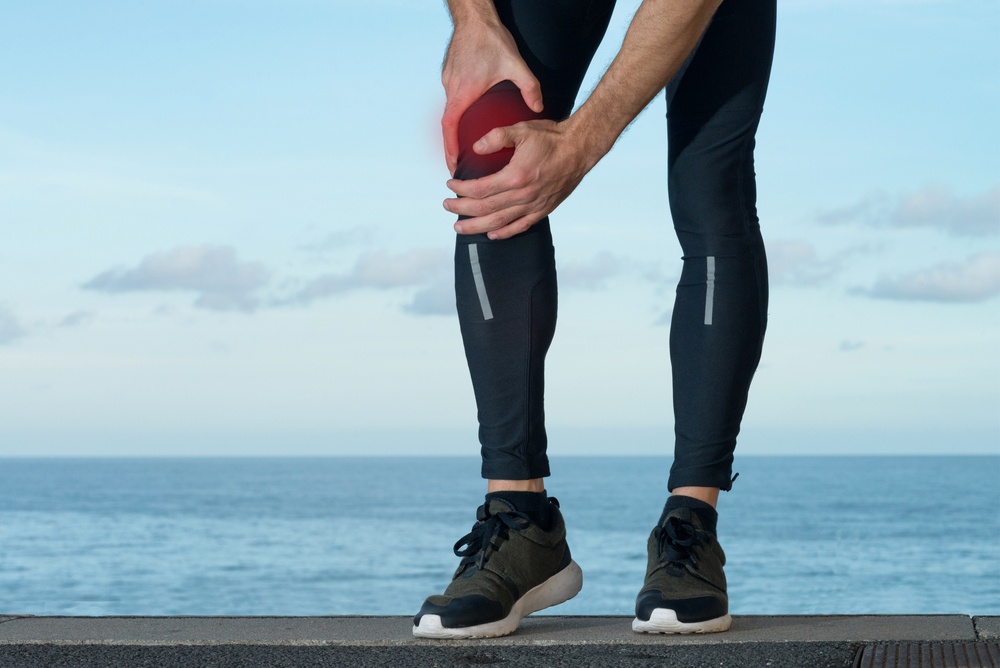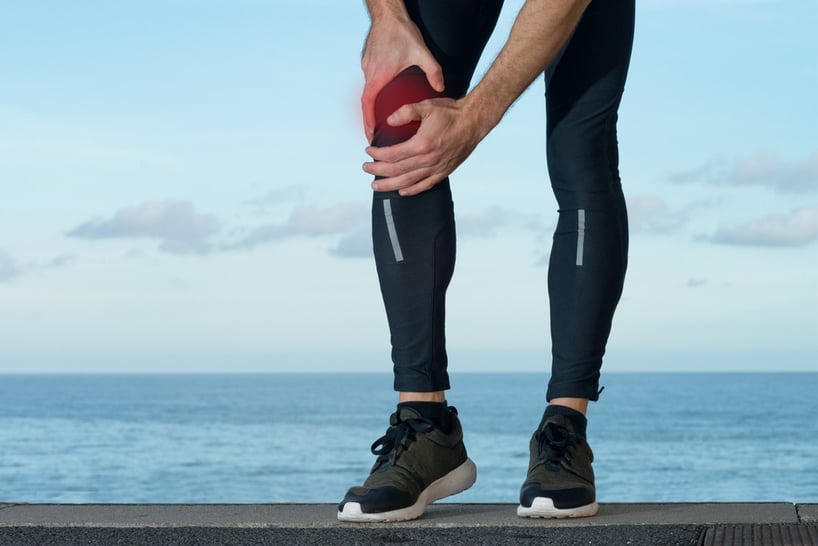Knee Sprains: Causes, Risk Factors, and Symptoms
November 14th, 2017 | 6 min. read


Have you ever landed funny when making a jump shot in basketball and felt something pop inside your knee? Or maybe you’ve smacked your knee hard on a coffee table; been checked against the wall playing hockey; or twisted, pivoted, or side-hopped awkwardly while skiing, dancing, or playing any number of sports.
Suddenly you find your knee hurts and it’s buckling under your weight. Maybe you even go down, tripping in the stairs or collapsing on the playing field or court. Within a few hours, you may notice swelling and tenderness, and possibly some limited mobility in the knee.
If this has happened to you recently, you may have a knee sprain: an injury affecting one of the four main ligaments—strong bands of connective tissue—that pass through the knee joint and connect your upper leg bone to your lower leg bones.
The Four Ligaments of the Knee
The four ligaments of the knee are:
- Anterior cruciate ligament (ACL). “Anterior” means front or forward, and “cruciate” means cross-like. In tandem with the posterior cruciate ligament (PCL), the ACL creates a diagonal cross shape in the center the knee joint. Together, these two ligaments stabilize the knee and control the forward and backward motions of the lower leg (e.g., bending your leg at the knee and straightening it, as you might when winding up and following through when kicking a soccer ball).
If you follow sports or are an athlete, you’ve probably heard of the ACL; professional and college athletes frequently damage it, and often dramatically. When you injure your ACL, it’s not uncommon to “go down fast,” collapsing under your body weight. The injury is almost always painful and usually disabling, at least in the short term.
- Posterior cruciate ligament (PCL). Anterior means “front.” Posterior means “back.” The PCL crosses through the joint and controls the backward motion of the shin. It’s a stronger ligament than the ACL and is less commonly injured. PCL sprains are usually not as painful and disabling as ACL sprains. Often they can heal on their own.
- Medial collateral ligament (MCL). Two ligaments of the knee stabilize the sides of the knee joint (the inside and the outside). The MCL braces the knee on the inside. Sprains to this ligament usually result from direct blows to the outside of the knee that cause the knee to move suddenly inward. (For example, a low football tackle or a hard kick might damage the MCL.) Sudden twisting motions and awkward, wrenching falls can also damage the MCL.
- Lateral collateral ligament (LCL). The LCL braces the outside of the knee joint. Of the four ligaments of the knee, the LCL is injured the least; not because it’s innately stronger, but because the pressure forces that would cause it to strain or tear would come from opposite side of the leg—the inner surface of the thigh and knee. This type of directional force is uncommon in the course of daily living or participating in most sports.
The knee is at the crux of everything active people do: walking, running, jumping, climbing, bending the leg, kneeling, and kicking. Thus it’s the most commonly injured body part among athletes, especially high school athletes.
Causes of Knee Sprains
Like all sprains, a knee sprain is an overstretching or tearing of a ligament. Usually, this type of injury is the result of a sudden movement or force.
- Over-extensions (hyperextension of the knee) can damage your ACL. This type of injury may occur when you kick with force. A direct, forceful impact to the lower leg may have a similar effect. (For example, if someone kicks your calf from behind, or if you’re struck by a moving vehicle.)
- Sudden compressions or forceful impacts. Sideways blows to the outside of the knee (for example, a classic sideways football tackle) can cause MCL sprains.
- Quick and sudden twists, pivots, and changes in direction can sprain the ACL. Wrenching your knee can also damage the MCL.
- Landing on your feet after a big jump—for example, when making a basketball shot, sticking a gymnastics landing, or leaping over a ski mogul— can sometimes sprain the ACL.
- Falls and accidents. A hard blow to the outside of the knee or to the lower leg can twist and wrench the knee, damaging the ACL. Landing hard on a bent knee (for example, if you fall forward onto your knees or dive for a volleyball or baseball) can damage the PCL. The PCL can also be damaged by any hard blow to the front of the knee, such as striking it against a solid wall or sustaining a blow from a baseball bat. The MCL may sprain if you fall with your lower leg twisted away from your body.
Risk Factors for knee sprains
The biggest single risk factor for a knee sprain is activity. If you’re an athlete, you’re more likely to overstretch one of the knee ligaments due to the high level of activity in which you participate.
You’re at a greater risk if you’re a casual, part-time athlete who’s out of condition. Sprains and strains are very common in weekend warriors.
You’re also at risk if you don’t cool down and stretch after workouts, or warm up before them.
Specifically, the following activities may put you at risk for particular knee sprains:
- ACL sprains: If you play basketball, football, soccer, or rugby; if you’re a gymnast, dancer, competitive cheerleader, or wrestler; or if you ski. Women and girls also have an increased risk of ACL injury.
- MCL sprains: If you play football, hockey, rugby, or soccer; also, if you engage in activities that could involve lower leg twisting motions when you fall (e.g., skiing, wrestling, certain types of dance).
- PCL sprains: If you play basketball, football, soccer, or rugby. Any sudden, hard kneeling motion could also hurt the PCL (e.g., certain dance moves).
Symptoms of a knee sprain
Symptoms of a knee sprain vary depending on which knee ligament you’ve injured. Nearly all knee sprains, however, have some or all of these symptoms:
- Bruising. Some knee sprains will be accompanied by noticeable bruising (black-and-blue) around the site of the injured ligament. This is most common with ACL sprains. The bruising is generally on the front of the kneecap and in the area surrounding it.
- Instability. The knee may buckle beneath your weight, or when you move from side-to-side. You may not feel confident you can stand without falling. Some instability will be the case for:
- ACL sprains (you may not be able to put weight on the knee at all)
- LCL sprains (knee may buckle toward the inside of the leg)
- MCL sprains (knee may buckle toward the outside of the leg)
- PCL sprains (knee may buckle from behind, but not always)
- Pain when you put weight on your leg or try to move normally.
- ACL sprains usually result in severe knee pain in the mid-center of the knee. You may have trouble standing and walking. Immediately following your sprain, participation in sports, dance, and other weight-bearing activities is likely impossible.
- LCL sprains (at the outside of the knee)
- MCL sprains (at the inner side of the knee)
- PCL sprains (milder pain, at the back of the knee; this soreness is more noticeable when bending the knee and kneeling)
- Popping sound or sensation at the time of injury. This is most common with ACL sprains. If you hear or feel a popping deep inside the knee at the time of injury, you may have sprained your ACL.
- Stiffness/Immobility. Following your knee sprain, you may have some trouble bending and straightening the knee. This is most often the case with PCL sprains. Other sprains may experience difficulty with lateral motions.
- Swelling over the knee, though the location and extent of this swelling may vary depending on which ligament has been torn. All types of knee sprains tend to have some degree of swelling.
- ACL sprains tend to swell a good deal, within 2-3 hours following the initial injury.
- LCL sprains and MCL sprains tend to swell over the affected ligaments (the outside or inside of the knee).
- PCL sprains have minor swelling over the back of the knee.
- Tenderness over the site of the injury—again, this will vary depending on the knee ligament that has been injured.
- LCL sprain (at the outer side of the knee, over the LCL)
- MCL sprain (at the inner side of the knee, over the MCL)
If You Think You’ve Sprained Your Knee
Take your weight off the injured knee, rest your leg, ice the injury, and take NSAIDs to control pain and swelling immediately after the injury. Then make an appointment to see a doctor as soon as you’re able.
A physician, sports medicine doctor, or orthopedist can examine your knee to determine the extent of your ligament damage and to confirm the knee sprain, if that is indeed the injury you have.
In some cases, what you might think is a sprain may actually be a more severe injury, such as a ruptured ligament or a tear. (Confirming such injuries often requires imaging tests like X-ray or arthroscopy.) Severe ligament tears and ruptures may require arthroscopic knee surgery to mend and reattach torn tissue.
Also, sometimes the knee damage may be a sprain plus something else, like a fracture or damage to more than one ligament.
At your visit, your doctor will tell you if you have a Grade I, II, or III sprain, or something else entirely. Then he or she will advise you on how to treat and rehabilitate your knee going forward.
Please contact Coastal Orthopedics located in Corpus Christi, Texas to schedule an appointment if you suspect a knee sprain today at (361) 994-1166.
Article written by: Rob Williams, MD
Dr. Williams has been practicing orthopedic surgery in Corpus Christi since 1998. After graduating from Texas Tech hereceived his medical degree from the University of Texas at San Antonio. At the prestigious Campbell Clinic located at the University of Tennessee, Dr. Williams completed not only an Orthopedic Surgery Residency, but an additional year of Fellowship Training in Spine Surgery. Dr. Williams is dedicated to creating an excellent patient experience in the office or in the surgery suite.
Topics:


